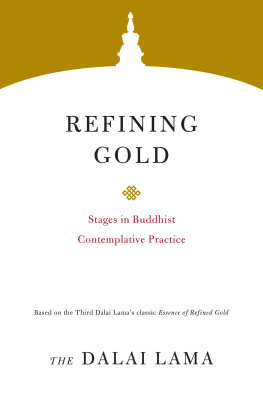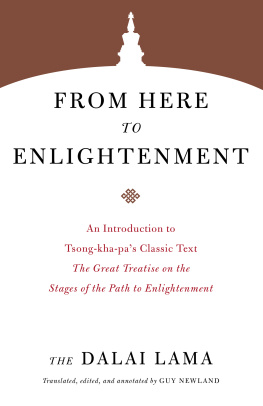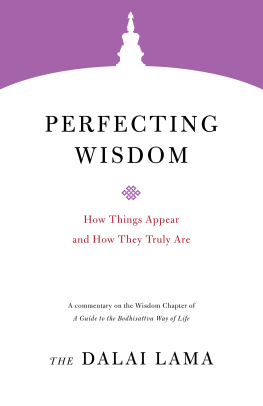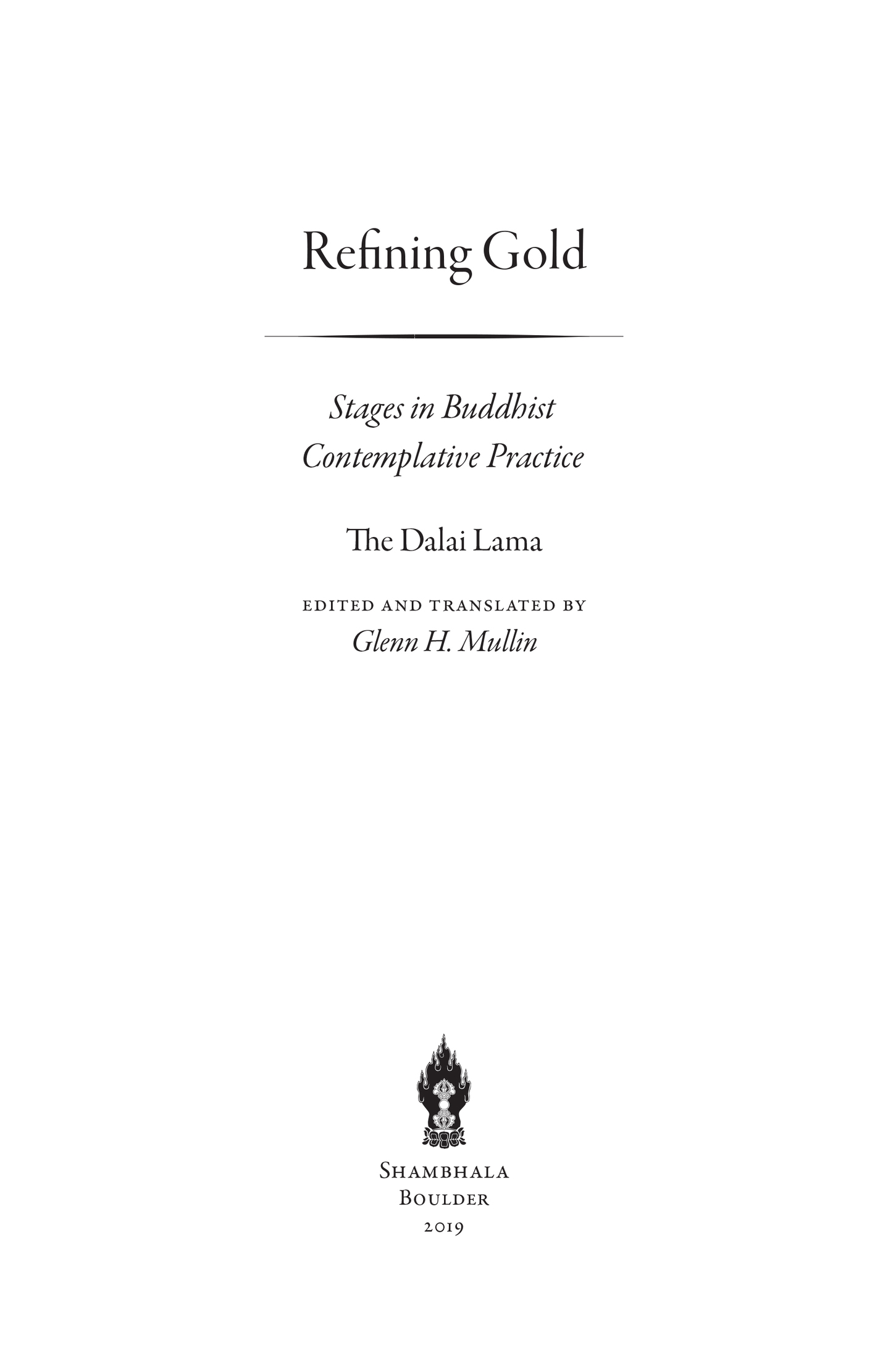Contents
Landmarks
Print Page List
Shambhala Publications
4720 Walnut Street
Boulder, Colorado 80301
www.shambhala.com
1982, 1994 by H.H. the Dalai Lama, Tenzin Gyatso, and Glenn H. Mullin
Earlier versions of this book were published under the titles The Path to Enlightenment (Snow Lion, 1994), Selected Works of the Dalai Lama III : Essence of Refined Gold (Snow Lion, 1985), and Essence of Refined Gold (Snow Lion, 1982).
All rights reserved. No part of this book may be reproduced in any form or by any means, electronic or mechanical, including photocopying, recording, or by any information storage and retrieval system, without permission in writing from the publisher.
Cover design by Claudine Mansour Design
Library of Congress Cataloging-in-Publication Data
Names: Bstan-dzin-rgya-mtsho, Dalai Lama XIV , 1935 author. | Mullin, Glenn H., editor, translator. | Bsod-nams-rgya-mtsho, Dalai Lama III , 15431588. Byang chub lam gyi rim pai khrid yig gser zhun ma. English. Title: Refining gold: stages in Buddhist contemplative practice/The Dalai Lama; edited and translated by Glenn H. Mullin.
Other titles: Path to enlightenment.
Description: Boulder: Shambhala, 2019. | Previously published as The Path to Enlightenment (Snow Lion, 1994). | Includes the text of Essence of refined gold in English. | In English, translated from the original Tibetan. | Includes bibliographical references and index.
Identifiers: LCCN 2018058531 | ISBN 9781611807332 (pbk.: alk. paper)
eISBN 9780834842342
Subjects: LCSH : Lam-rim. | Bsod-nams-rgya-mtsho, Dalai Lama III , 15431588. Byang chub lam gyi rim pai khrid yig gser zhun ma. |Tsong-kha-pa Blo-bzang-grags-pa, 13571419. Lam rim bsdus don.
Classification: LCC BQ 7645. L 35.B7633 2019 | DDC 294.3/923dc23
LC record available at https://lccn.loc.gov/2018058531
v5.4
a
In memory of Bakshi Geshe Wangyal,
a most skilled teacher,
founder of the Buddhist Monastery of America,
Washington, New Jersey
C ONTENTS

F OREWORD

T HE T HIRD D ALAI Lama, Gyalwa Sonam Gyatso, a supremely high one with power over the three worlds, was invited by Altan Khan to visit the Mongol nation. He accepted, and the marvelous deeds that he performed there in order to propagate the Buddhadharma in general and the doctrines of the Second Buddha Tsongkhapa in particular left a lasting impression on the land.
One of the Third Dalai Lamas most popular written works is his Essence of Refined Gold, which extracts the heart of Lama Tsongkhapas Great Exposition of the Stages on the Spiritual Path. Although brief, it summarizes the meaning of all Buddhas teachings and is easily put into practice.
A few years ago His Holiness the Fourteenth Dalai Lama, a master of all doctrines, gave a discourse upon the Third Dalai Lamas Essence of Refined Gold to a number of fortunate trainees. I offer my prayers that Glenns translation of the root text and his compilation of a commentary based upon His Holiness discourse may be of lasting spiritual benefit to those in the great Western Lands with a sincere interest in the Buddhist path to enlightenment.
Yongzin Trijang Rinpoche
Junior Tutor to H.H. the Dalai Lama
Fifteenth Day of the Fourth Tibetan Month,
Iron Bird Year
F OREWORD

I AM VERY HAPPY and honored to write a brief foreword to this excellent work presenting His Holiness the present Dalai Lamas commentary on The Essence of Refined Gold by Sonam Gyatso, the Third Dalai Lama of Tibet. I feel it is especially auspicious in that Glenn Mullin has dedicated the volume to my original teacher, the late Venerable Geshe Wangyal, whose tireless efforts have been instrumental in helping His Holiness the Fourteenth Dalai Lama spread the Buddhadharma in America. The taming of America is similar in many ways to His Holiness the Third Dalai Lamas taming of Mongolia.
The Dalai Lamas of Tibet are one the wonders of our planetary history, and their contribution has not at all come to an end. They are the political and spiritual reincarnation of the Bodhisattva, or Buddhist Messiah, Avalokiteshvara, who comes into our violent history to tame our emotional wildness and enlighten our intellectual confusion.
The deeds of Sonam Gyatso, such as the taming of the fiery Mongol nations, bear striking witness to the power of the spirit of enlightenment, with its detachment, love, and wisdom triumphant over egotism, greed, and violence. Glenn Mullin is a skilled translator of Tibetan, whose devotion to His Holiness the present Dalai Lama and religious commitment to realizing the Dharma shine through his well-chosen words. His useful work proves that academic linguistic qualification is only a first step in the process of translation. After it must come a commitment to the spirit of the original writings, a selfless determination to submerge the ego formed in a mother culture into the culture of the original text, and then a single-minded discipline to reconstruct the vitality and integrity of the original in the mother tongue.
The great translators of Tibet, who brought the Buddhist civilization to their people, were never concerned with their personal fame or profit. Yet they were honored as eyes of the nation (Tib., Lo-tsva-ba; Skt., Lokacakshu), national treasures who became living eyes for their contemporaries to see the wisdom and beauty of the worlds beyond their borders. Glenn Mullin has joined this ancient fraternity of Lotsawas by giving us a wonderful series of works revealing the inner life and outer deeds of all the Dalai Lamas. May all enjoy them and be inspired by the gentle triumphs of this prince of peace. And may His Holiness the living Dalai Lama long continue creating yet another such wonderful biography on the planetary scale of modern times!
Prof. Robert Alexander Farrar Thurman
March 14, 1985
Amherst College, Massachusetts
T RANSLATOR S I NTRODUCTION

W HENEVER HE TAUGHT , the Third Dalai Lama Gyalwa Sonam Gyatso set aside magic and mystery and spoke only on the basic foundations of Buddhist practice, the simple everyday methods for cultivating spiritual awareness. His teachings had a profound influence on the people who came to hear him, and wherever he went he left behind monasteries and spiritual centers that over the centuries to follow would reshape the civilizations he had contacted. Due to his work the gentle doctrines of the Buddha spread like the rising sun over a land that previously had known only conflict and war.

















